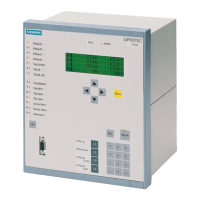'(& )( )'& &) ( &!& ")& &$(( $# Ć %&( $# #)" &&#$
5 - 11
Siemens AG ⋅ May 1998
The bays (bay units) can be configured as bus coupĆ
lers, feeders or sectionalizers ( ).
The number of bays in a station is defined by the first
bay configured as "non-existent" ( ).
Depending on the size of the station, the hardware
design of the master unit can be adapted in steps of 8
connections for bay units.
One bay unit is allocated to each feeder and each
sectionalizer. The station configuration can include up
to 4 bus couplers and 24 sectionalizers. Two bay units
are allocated to each bus coupler.
For further explanations about connection and setting
of the bus coupler bays please refer to chapter 5.2.1.
For configuration of the bays the following sequence
is binding:
D Bus coupler bays before feeder bays before secĆ
tionalizers.
Up to 5 isolators can be connected to each bay unit.
Isolators 1 to 3 are allocated to the busbar isolators.
Isolator 4 can be configured as busbar isolator or
transfer bus isolator, depending on the setting
.
Pre-requisite for protecting the transfer (bypass) bus
or combi-bus is the line-side (out-side) location of
the current transformer in the feeder bays (Fig 5.7)
and release via parameter .
The parameter "CT location" ( ) is evaĆ
luated only for transfer bus or combi-bus operation.
For bus coupler bays, its setting has no influence on
the protection function.
The parameter "CT polarity" ( ) offers
the same setting options as the parameter
.
The setting is determined by the station-specific locaĆ
tion of the current transformers. The CT polarity defiĆ
nes the direction of the current flow for evaluation in
the protection program.
In Fig 5.7 the setting "line-side" has to be selected
for all feeder bays. The current transformer of the 1st
bus coupler measures the current for bay 1. As a conĆ
sequence, an identical CT polarity is selected in relaĆ
tion to the feeder bays. The virtual current transforĆ
mer for bay number 2 is set in opposite direction
"bus-side" (refer also to chapter 5.2.1).
Isolators 1 to 4 can be used as sectionalizers, depenĆ
ding on the type of bay. In bay units of the type "secĆ
tionalizer", isolators 1 to 4 can only be used as sectioĆ
nalizers. A maximum of 24 sectionalizers can be
configured per station.
From each isolator, an auxiliary contact is wired to the
bay unit for recognition of the OPEN-status and one
auxiliary contact for the CLOSED-status.
The binary inputs BI 1 to BI 10 are pre-selected (refer
to chapter 6.4.2.2). The LED indications allocated to
the binary inputs are GREEN for the OPEN-status
and RED for the CLOSED-status.
The functions can freely be allocated to the binary
inputs as well as to the LEDs in the bay unit.
The isolators existing in each bay are identified by
parameters to . The allocation
of the isolators to the bus sections is done by the bus
section number (refer also to chapter 6.2.3.3).
Isolator 5 is exclusively used as feeder isolator in the
bay type "outgoing feeder" and is configured via paĆ
rameter .
In the status "bay out of service" all configured isolaĆ
tors of this bay are assumed by the 7SS52 to be
OPEN. In case of bus coupler bays, this applies autoĆ
matically for both bay units.

